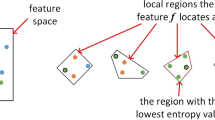Abstract
This paper explores the classification capability of features by three ways, respectively: decision tree/random forest, hierarchical clustering and WordNet. To simulate the human judgment process, first, a decision tree is first constructed to reflect the importance of features. The model performs worse when top 5 features and top 10 features are used separately than when the all features are used, showing that the top k feature set omits some information that are important to classification. Second, hierarchical clustering is used to show the relationships between high-level features of different classes. The ward linkage method is selected to construct the hierarchical clustering tree. The parts of the adjacent classes with higher feature overlap are mapped back to the original image to visually show common features captured by the CNN network. Finally, to study the semantic value of neural network classification, the WordNet semantic structure is applied to fit the image classification process. However, results are relatively poor, demonstrating the inconsistency between the WordNet classification and machine learning classification.
Shan Wang and Yue Wang contributed equally to this work. This work is supported by: National Defense Science and Technology Innovation Special Zone Project (No. 18-163-11-ZT-002-045-04); Engineering Research Center of State Financial Security, Ministry of Education, Central University of Finance and Economics, Beijing, 102206, China; Program for Innovation Research in Central University of Finance and Economics; National College Students’ Innovation and Entrepreneurship Training Program “Research on classification and interpretability of popular goods based on Neural Network”.
Access this chapter
Tax calculation will be finalised at checkout
Purchases are for personal use only
Similar content being viewed by others
References
Litjens, G., Kooi, T., Bejnordi, B.E., et al.: A survey on deep learning in medical image analysis. Med. Image Anal. 42, 60–88 (2017)
Brennan, T., Oliver, W.L.: Emergence of machine learning techniques in criminology: implications of complexity in our data and in research questions. Criminol Pub. Pol’y 12, 551 (2013)
Angermueller, C., Pärnamaa, T., Parts, L., Stegle, O.: Deep learning for computational biology. Mol. Syst. Biol. 12(7), 878 (2016)
Rui, Y., Huang, T.S., Chang, S.F.: Image retrieval: past, present, and future. J. Vis. Commun. Image Represent. 10(1), 1–23 (1999)
Han, J., Zhang, D., Cheng, G., Guo, L., Ren, J.: Object detection in optical remote sensing images based on weakly supervised learning and high-level feature learning. IEEE Trans. Geosci. Remote Sens. 53(6), 3325–3337 (2014)
Zhao, W., Du, S., Emery, W.J.: Object-based convolutional neural network for high-resolution imagery classification. IEEE J. Sel. Top. Appl. Earth Observations Remote Sens. 10(7), 3386–3396 (2017)
Girish, D., Singh, V., Ralescu, A.: Unsupervised clustering based understanding of CNN. In CVPR Workshops, pp. 9–11 (2019)
Wang, L., Khan, L.: A New Hierarchical Approach for Image Clustering. Multimedia Data Mining and Knowledge Discovery, pp. 41–57. Springer, London (2007)
Singh, C., Murdoch, W.J., Yu, B.: Hierarchical interpretations for neural network predictions. arXiv preprint arXiv:1806.05337 (2018)
Gómez, D., Yáñez, J., Guada, C., et al.: Fuzzy image segmentation based upon hierarchical clustering. Knowl.-Based Syst. 87, 26–37 (2015)
Jin, Y., Khan, L., Wang, L., Awad, M.: Image annotations by combining multiple evidence & wordnet. In: Proceedings of the 13th Annual ACM International Conference on Multimedia, pp. 706–715 (2005)
Benitez, A.B., Chang, S.F.: Image classification using multimedia knowledge networks. In: Proceedings 2003 International Conference on Image Processing, pp. III-613 (2003)
Deng, J., Dong, W., Socher, R., Li, et al.: Imagenet: a large-scale hierarchical image database. In: 2009 IEEE Conference on Computer Vision and Pattern Recognition, pp. 248–255 (2009)
Lakkaraju, H., Kamar, E., Caruana, R., Leskovec, J.: Interpretable & explorable approximations of black box models. arXiv preprint arXiv:1707.01154 (2017)
Zilke, J.R., Mencía, E.L., Janssen, F.: Deepred–rule extraction from deep neural networks. In: International Conference on Discovery Science, pp. 457–473 (2016)
Silva, A., Gombolay, M., Killian, T., et al.: Optimization methods for interpretable differentiable decision trees applied to reinforcement learning. In International Conference on Artificial Intelligence and Statistics, pp. 1855–1865 (2020)
Wan, A., Dunlap, L., Ho, D., et al.: NBDT: neural-backed decision trees. arXiv preprint arXiv:2004.00221 (2020)
Li, J., Chen, X., Hovy, E., Jurafsky, D.: Visualizing and understanding neural models in nlp. arXiv preprint arXiv:1506.01066 (2015)
Selvaraju, R.R., Cogswell, M., Das, A., et al.: Grad-cam: visual explanations from deep networks via gradient-based localization. In: Proceedings of the IEEE International Conference on Computer Vision, pp. 618–626 (2017)
Ribeiro, M.T., Singh, S., Guestrin, C.: “Why should i trust you?” Explaining the predictions of any classifier. In: Proceedings of the 22nd ACM SIGKDD International Conference on Knowledge Discovery and Data Mining, pp. 1135–1144 (2016)
Zeiler, M.D., Fergus, R.: Visualizing and understanding convolutional networks. In: European Conference on Computer Vision, pp. 818–833 (2014)
Russakovsky, O., Deng, J., Su, H.: Imagenet large scale visual recognition challenge. Int. J. Comput. Vision 115(3), 211–252 (2015)
Author information
Authors and Affiliations
Editor information
Editors and Affiliations
Rights and permissions
Copyright information
© 2021 Springer Nature Singapore Pte Ltd.
About this paper
Cite this paper
Wang, S., Wang, Y., Zhao, Q., Yang, Z., Guo, W., Wang, X. (2021). Exploring Classification Capability of CNN Features. In: Zeng, J., Qin, P., Jing, W., Song, X., Lu, Z. (eds) Data Science. ICPCSEE 2021. Communications in Computer and Information Science, vol 1451. Springer, Singapore. https://doi.org/10.1007/978-981-16-5940-9_21
Download citation
DOI: https://doi.org/10.1007/978-981-16-5940-9_21
Published:
Publisher Name: Springer, Singapore
Print ISBN: 978-981-16-5939-3
Online ISBN: 978-981-16-5940-9
eBook Packages: Computer ScienceComputer Science (R0)




